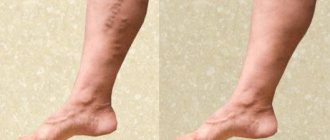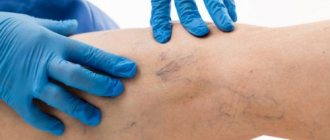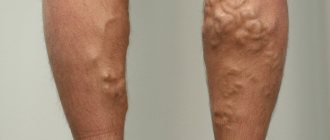Varicose veins of the penis are most often associated with a hereditary predisposition. This disease involves an enlargement of the veins on the penis by more than 6 mm. The disease is very unpleasant and can result in impotence, therefore, if you notice signs of varicose veins, you need to urgently make an appointment with a urologist.
Signs of varicose veins of the penis
The content of the article
The first signs of varicose veins on the penis are practically invisible. With the development of pathology, unpleasant sensations in the penis will be felt during sexual intercourse and urination:
- Due to the constant pressure of blood in the veins on the organ, the man experiences frequent urination, accompanied by unpleasant pain.
- Painful, pinching, tingling sensations in the penis during and without an erection.
- With varicose veins, pain can also occur during sexual intercourse, and especially during ejaculation.
- Swellings and veins twisting into knots and enlarged in size appear on the penis; abnormal swelling and associated redness can be noted. The formations can be easily felt when touching the penis.
If the disease is not treated, the veins increase in volume so much that huge lumps may appear on the penis itself, the number and size of which increases, causing pain to the patient. Vein anomalies become especially noticeable during an erection.
For some reason, a vein on the penis is swollen: what to do?
Based on the appearance of the swelling on the penis, we can assume its cause.
First of all, the doctor pays attention to the color, shape, and consistency of the formation.
Its location is also important.
The swelling may be homogeneous or filled with fluid.
This fluid may be pus, blood, or serous exudate.
Sometimes the swelling is dense, and then the doctor thinks about a tumor, vegetation, scar changes.
In other cases it is soft.
Perhaps it is a vesicle, bubble, dilated vein.
The color can be blue, red, white, and sometimes the swelling is transparent, and you can see the liquid inside.
There can be a huge number of reasons for such changes.
The main ones:
- infections
- injuries
- vascular diseases
- tumors
- allergy
- dermatological diseases
The blue swelling can be anything.
For example:
- dilated vessel
- bruise
- skin formation
- thrombus inside a vein
- vascular formation
- anomaly of vascular development
- inflammation of the venous wall
Most often, a bulging vein in the penis appears.
This may be the result of varicose veins.
It develops both in isolation and as one of the manifestations of pelvic varicose veins.
The blue swelling may represent a normal bruise.
It is blue because blood has accumulated under the skin.
If there is a lot of it, it lifts the skin, so bloating appears.
Sometimes swelling occurs.
The cause of a bruise on the penis may be an injury received during sex.
The risk is higher with a long duration of sexual intercourse and the use of local anesthetics to prolong it.
Sometimes the cause is a blood coagulation disorder.
But in this case, bruises appear not only on the penis, but also on other parts of the body.
This is a rare vascular anomaly.
It is often confused with hemangioma during examination.
It appears mainly in adolescence or young adulthood.
Venous malformations can form on any part of the body.
They have different colors: from bluish to burgundy-red.
During puberty, there is a sharp increase in vascular formation in size.
Problems arise with sex life.
The malformation can easily become injured and cause significant bleeding.
Main symptoms:
- blue swelling on the head of the penis
- swelling of the penis
- pain
The disease is easily curable, but requires invasive procedures.
Treatment options:
- sclerotherapy
- surgical removal of malformation
- laser therapy
Thrombosis is usually caused by:
- injuries
- promiscuity and subsequent sexually transmitted infections
- bladder overdistension
- previous operations on the pelvic organs
- long delay in ejaculation
- using condoms with local anesthetics
Normally, the vessels located on the surface of the penis are almost invisible, or have a diameter of up to 3 mm.
Sometimes they expand, become inflamed, and blood clots appear inside.
Treatment requires:
- abstinence from sexual intercourse
- taking anti-inflammatory drugs
- local use of anticoagulants (heparin ointment)
In case of acute venous thrombosis, thrombectomy is required.
The thrombus is most often located in the area of the coronary sulcus.
It is small in size, but quite sufficient to stop the flow of blood through the blood vessel.
The veins of the penis are not isolated from other vessels.
They are part of a single venous network of the genitourinary organs.
It also includes the veins of the prostate, testes, and testicles.
Therefore, often a man with varicose veins of the pelvis simultaneously experiences pelvic pain, varicocele, and dilated veins of the penis.
Swellings of different sizes appear under the skin of the penis.
Swollen veins become hard.
Their density is more like a tendon than a blood vessel.
Later pain and discomfort arise.
Possible tingling during sexual intercourse.
The diagnosis is made based on examination, palpation and Dopplerography of the penis.
Treatment of varicose veins of the penis can only be surgical.
Conservative methods provide only a temporary effect.
But they do not eliminate symptoms forever, or even slow down the progression of the disease.
Treatment requires ligation (ligation) or excision of dilated veins.
Sclerotherapy can be performed - the injection of a substance that glues the walls of the veins.
Laser coagulation is also used.
The red swelling may be vascular or contain infiltrate.
To understand its origin, the doctor presses the glass on the skin of the penis.
If the swelling immediately turns pale, it may be a hemangioma.
Most red swellings are of inflammatory origin.
The reasons are:
- folliculitis
- sexually transmitted infections
- fungal inflammation
- allergy
- any damage (burns, injuries)
- contact dermatitis (usually develops as a result of attempts to self-medicate condylomas with caustic alkalis or acids)
Blisters can be colorless, white, pink, etc.
Let's look at the main diseases in which they occur.
There can be many reasons for swelling on the penis.
It is not always possible to determine the cause based on examination alone.
In most cases, doctors have to resort to tests and instrumental studies.
Can be assigned:
- smears and urethral scrapings for genital infections
- sowing for flora or fungi
- coagulogram
- blood test for allergies
- determination of antibodies to the causative agent of syphilis
The doctor performs a dermatoscopy, an examination of the skin of the penis under a Wood's lamp.
If the swelling is blue, ultrasound and Doppler ultrasound are prescribed.
If necessary, a skin biopsy is performed with its pathomorphological examination.
It is not the swelling itself that is treated, but the disease that caused it.
Therefore, it differs greatly, depending on the identified pathology.
Some diseases are treated with conservative methods.
To combat other pathologies, minimally invasive procedures or surgeries are required.
Any infectious processes that cause the appearance of one or multiple swellings are subject to conservative treatment.
In the case of syphilis or streptoderma, preference is given to penicillin drugs.
If the bloating disease is caused by Gardnerella, nitroimidazole derivatives are used.
For candidiasis, miconazole or other antimycotics are prescribed.
Herpes infection is treated with acyclovir or other acyclic nucleosides.
Vascular formations, vegetations, and dilated veins must be removed using minimally invasive methods.
Laser, sclerotherapy, radio wave removal, and electrocoagulation are used.
Surgical excision or ligation (ligation) of the veins may be performed.
Vegetations caused by the papilloma virus can be removed within a few minutes by various types of physical energies.
To combat dilated veins, the doctor’s task is to either remove them completely along with blood clots, or block the lumen.
If the veins are small and there are no blood clots, the second approach is more often used.
To block the lumen of a vessel, a phlebologist either introduces a special substance inside the vessel that glues the walls together, or damages the endothelium with a laser, initiating reparative processes, and then the veins simply become overgrown.
If swelling appears on the penis, contact our clinic.
We employ highly qualified urologists and dermatovenerologists.
They will examine you and take the necessary tests.
If necessary, instrumental studies will be performed.
After making a diagnosis, the doctor will determine therapeutic tactics.
In most cases, swelling on the penis can be eliminated using conservative methods.
We use modern treatment methods that result in a minimum of complications and relapses, allowing you to quickly solve the medical problem.
If swelling appears on the penis, contact the author of this article, a dermatovenerologist in Moscow with many years of experience.
In the first stages of the disease, penile varicose veins in men practically do not appear for a long time. But there is a main sign of this disease - these are small subcutaneous tubercles on the veins, which over time begin to increase in size and number, and a slight deformation of the organ is observed.
Varicose veins of the genital organ
Already at the next stage, when the disease is advanced, you can see hard areas on the head of the penis. In this case, the veins on the genital organ, especially in a state of arousal, significantly increase in diameter, exceeding 4 mm.
- If the veins are very swollen and hardened;
- The color of the veins is dark blue;
- When palpated, nodules are felt;
- Touching the veins causes discomfort;
- Feeling of pain during sexual intercourse;
- Aesthetic changes in the penis.
- Injuries in the groin area and penis, and as a result, varicose veins in the groin in men;
- Tumors in the intimate area;
- Regular masturbation, which leads to stagnation of blood in the pelvic organs and penis;
- Surgeries on the pelvic organs;
- Frequent use of stimulants;
- Frequent attempts to prolong ejaculation;
- Blood thrombosis;
- Frequent urinary retention;
- Previous venereal diseases.
Of course, varicose veins of the penis do not pose a mortal danger to the health of men, but, nevertheless, they can bring some significant changes and inconveniences to life.
- Feeling of pain, discomfort and tingling in the penis, especially during erection;
- Burning and rubbing of the scalp during sexual intercourse;
- Violation of the appearance of the penis;
- Formation of blood clots at the tip of the penis;
- Dilatation of the veins of the spermatic cord (varicocele).
The self-diagnosis method for this disease is quite simple. After looking at a photo where varicose veins of the penis are visible, you can compare the surface of your genital organ with it. Even the slightest changes should not be ignored. Also, carefully examine the testicles for varicoceles. Feel the entire length of the penis for the presence of tubercles.
If you consult a specialist, a phlebologist, they will prescribe an ultrasound examination of your blood flow and, if necessary, phlebography.
It is worth remembering that you should not diagnose and treat varicose veins of the penis on your own; it is recommended to consult a specialist to establish the correct diagnosis. Indeed, sometimes varicose veins provoke venous thrombosis near the corolla of the head. In this case, only surgical intervention will save the situation.
During treatment, you should stop having sexual relations, taking antibiotics, and refrain from masturbation. During treatment, it is recommended to switch to proper nutrition and add a little physical activity, stop smoking and drinking alcoholic beverages.
Content
Complications
If swelling on the penis does not cause inconvenience and does not cause pain, it may be just a temporary deformation of the muscles and tendons of the penis, characteristic of male physiology, and not varicose veins.
But in any case, you need to see a urologist, since an advanced state of penile varicose veins can result in rupture of the veins during the next erection and internal or external hemorrhage. Such an ending, in the worst case, will lead to the complete loss of the functionality of the penis and complete impotence, and in the “best” - to infertility.
How is it diagnosed?
At the initial appointment, the doctor conducts a standard examination and gets acquainted with the patient’s complaints. To find out more about the visitor’s well-being, the doctor questions him in detail. A standard examination includes palpation and visual examination of the penis during erection and at rest. To confirm the diagnosis, the following examinations are prescribed:
- urine and seminal fluid tests;
- Dopplerography;
- phlebography.
Dopplerography is a diagnostic method using ultrasound, which is based on the Doppler effect. This is the name for the change in the frequency and length of the ultrasonic wave when the object under study moves. In the case of inguinal varicose veins in men, this object is blood. Doppler sonography is needed to assess the state of blood flow in the affected area.
Phlebography is a study of the condition of veins using x-rays. It differs from other methods in that the patient is first injected with a contrast agent, which allows the device to scan the entire vascular system.
If there is an assumption that penile varicose veins are a consequence of infection of the groin area, then additional procedures are prescribed to detect STDs. Sclerosing lymphangitis and Peyronie's disease have symptoms similar to varicose veins, so doctors can diagnose by exclusion.
Important information: Is it possible to do LPG massage for varicose veins of the legs and what are the contraindications?
The main reasons for the development of varicose veins
Varicose veins on the penis do not appear on their own. Knowing the reasons, you can protect yourself from unpleasant consequences. Usually the reason for the development of varicose veins in the veins of the penis are:
- Injuries during physical or sports training, blows delivered directly to the groin area.
- Improper functioning of the genitourinary system due to bladder diseases.
- Unsuccessful penile surgery associated with other diseases.
- Sexual life leading to constant changes of partners and infection with infectious diseases that cause swelling and inflammation in the genital area.
- The use of drugs that cause instant erection of the penis, arousal and abuse of alcohol and tobacco.
- Prolonged, exhausting sexual intercourse.
Varicose veins on the penis or varicose veins of the penis
What are varicose veins
Varicose veins (varicose veins) are a disease that occurs as a result of loss of elasticity of blood vessels with further deformation. Because of this, venous nodes, trophic ulcers, hemorrhoids, varicoceles and other diseases are formed. Most often, varicose veins occur on the lower extremities, but the arms, abdomen, neck or external genitalia are no exception.
Varicose veins on the penis can occur for many reasons, let's look at the most common ones:
- injuries to the groin area, especially the head of the penis;
- the occurrence of neoplasms in the column of the penis, which impair blood circulation;
- varicocele (varicose veins of the scrotum);
- thrombophlebitis of the lower extremities, due to which general blood circulation is disrupted;
- abnormal structure of the external genitalia;
- complications after surgery in the groin area;
- infectious diseases;
- atherosclerosis, which occurs due to metabolic disorders and excessive amounts of cholesterol in the blood;
- using various methods to delay ejaculation.
Varicose veins on the penis cannot be diagnosed independently; this is done by a specialist after a series of tests and studies. You can independently suspect the development of varicose veins based on the following symptoms:
- During an erection, tingling or burning is possible;
- venous nodes appear under the skin, which are visible to the naked eye;
- veins are visible on the penis, they become hard and excessively convex;
- swelling of the affected area;
- Hemorrhages may occur, which are clearly visible under the skin.
If such symptoms occur, you must contact a specialist who will confirm or refute the diagnosis and prescribe effective treatment.
A phlebologist deals directly with the vessels.
Considering the fact that varicose veins can develop against the background of another sexual disease, a consultation with a urologist or andrologist is necessary. In a critical situation, you will need the help of a vascular surgeon.
If the patient does not know which specialist to contact with a similar problem, then you can go to a therapist. He will write a referral to a specialist who will diagnose and prescribe a course of treatment.
What diet is indicated for varicose veins of the lower extremities?
Find out from this article how to relieve leg pain due to varicose veins.
Treatment options
There are several ways to treat varicose veins on the penis.
- Drug therapy, which includes taking medications. The effectiveness of treatment directly depends on the stage of the disease. If you detect varicose veins on the penis from the very beginning of the development of the pathology, then the probability of a complete cure without relapse is almost 100%. The course of treatment must include vascular-strengthening drugs (Detralex) and medications to thin the blood. In addition, you can use heparin ointment to relieve swelling and resolve nodes and blood stagnation. If after a week or two there is no result, the doctor may perform a simple procedure to remove excess blood from the penis. You can also use topical medications to relieve swelling, burning, itching (ointments, creams, balms).
- Traditional medicine based on natural ingredients. As an additional therapy to the drug treatment prescribed by the doctor, you can add traditional medicine methods that were used by our ancestors. Decoctions of the leaves and fruits of horse chestnut, mint, chamomile, string and calendula have proven themselves to be excellent. These plants have anti-edematous, vascular-strengthening, analgesic and regenerating effects. When doing procedures at home, it is important to remember that veins cannot be heated, so rubbing and compresses are prohibited.
- Hirudotherapy is treatment with live leeches. This technique was very popular 15 years ago. The salivary enzyme of the leech contains the substance hirudin, which is necessary to renew the chemical composition of the blood. Now science has artificially removed hirudin, so there is no strong need for leeches. However, many clinics practice these procedures.
- Surgery is a last resort option that is performed if varicose veins are in an advanced stage. Then the vascular surgeon, using special equipment, removes the damaged section of the vein. The operation is not long or difficult; after a couple of hours the patient can go home.
During treatment, you must be under the supervision of a doctor and strictly follow all his recommendations. You also need to temporarily stop sexual activity so as not to irritate damaged vessels with excessive blood flow.
Experts strongly recommend that when the first symptoms occur, contact a medical facility rather than try to take measures on your own. Self-medication can be harmful to health.
Prevention
Treatment of vascular diseases is a long and labor-intensive process. It's easier to warn them. In order to avoid varicose veins on the penis, men must adhere to the following rules:
- A healthy diet is one of the most important conditions for normal blood circulation and healthy blood vessels. It is very important to eliminate fatty and fried foods from your diet. The fact is that an excessive amount of cholesterol forms cholesterol plaques on the walls of blood vessels, which impair blood circulation and provoke the destruction of blood vessels.
- Rejection of bad habits. Alcohol and smoking in large quantities “slow down” intracellular metabolism, due to which the vessels are not saturated with all the necessary substances, and as a result, varicose veins occur.
- Measures to delay an erection should not be carried out too often, as this will impair blood circulation in the pelvic and genital areas.
- During infectious diseases, it is necessary to take medications to prevent varicose veins of the penis.
It is important to know that vascular diseases can be inherited, so it is necessary to take measures for those people who are at risk, that is, if men in the family had such a diagnosis.
Conclusion
To summarize, it can be noted that varicose veins on the penis are not a common occurrence, but the pathology is easily treatable.
The earlier a disease is diagnosed, the faster, easier, more effective and cheaper it is to get rid of it.
If you wait for it to “go away on its own,” as many do, then you can develop the last stage of varicose veins – a trophic ulcer, which is practically impossible to treat.
What it is?
In a calm state, the veins on the penis are hardly noticeable, but when an erection occurs, they greatly increase in size due to blood pressure. They become clearly visible and prominent.
Thus, the veins of the penis are also involved in maintaining and strengthening an erection. The norm is an increase in the diameter of the veins to 3–4 mm.
If the veins on an erect penis swell more strongly, then this is a reason to consult a doctor, since varicose veins of the penis are possible.
As in most cases, this type of varicose veins occurs due to deformation and excessive stretching of the veins, leading to thinning and damage to the vessel walls.
And this, in turn, can be triggered by a number of factors:
- Injury to the groin area, especially if the penis itself or its head is injured.
- The patient has vascular diseases in other parts of the body. This could be varicocele or thrombophlebitis of the legs. Or other diseases that affect blood circulation and vascular tone.
- Tumors in the groin area.
- If a man is forced to frequently delay urination due to external circumstances, or such delays occur due to pathologies.
- Hereditary predisposition.
- The veins in the genitals may be dilated due to complications after operations in the groin or on it itself.
- Sexually transmitted and infectious diseases or inflammatory processes caused by various reasons, including indiscriminate change of sexual partners.
- Many doctors with extensive experience and reputation associate varicose veins on the penis and the increase in the number of such cases with the spread of oriental sexual techniques among young people. They practice artificial delay of ejaculation in order to increase the duration of sexual intercourse. This leads to overstrain and damage to blood vessels.
- Abuse of masturbation, especially in middle-aged and older men. Here the veins on the penis are not subject to prolonged, but frequent and repeated tension. Which ultimately leads to the same result.
In addition to the above, men who lead a sedentary lifestyle, abuse alcohol and smoke, suffer from excess weight and constant stress are at risk.
But the further the disease develops, the more obvious and painful symptoms appear:
- Lumps and nodules of different sizes and in large numbers form on the penis, which leads to its deformation and negatively affects the aesthetic appearance.
- First, during sexual intercourse, when the penis is tense, and later in other situations (physical activity, etc.), the man begins to experience discomfort. It may be a stabbing and pulling pain or a burning sensation.
- The genital organ itself and the veins located on it vary greatly in color. The skin becomes deep red to purple, and the veins turn dark blue.
- An erection is accompanied by very strong swelling of the veins; in their density and appearance they begin to resemble tendons. blood clots and subcutaneous hemorrhages occur, which are visible visually or clearly palpable.
As you can see, if at the very beginning the disease is not dangerous and does not in any way affect the sexual and ordinary life of a man, then with the development of varicose veins, ignoring the problem can result in very unpleasant consequences.
Thrombosis, varicocele and other pathologies, including infertility and impotence. And all this will be aggravated by a host of psychological problems.
Therefore, it is so important to monitor the condition of the vessels of the penis, and not to postpone a visit to a phlebologist at the first warning signs.
Diagnostics
A qualified doctor diagnoses varicose veins of the penis without any problems.
There is a proven method for this:
- The doctor interviews the patient, listens to his complaints and collects anamnesis.
- A visual examination of the genital organ is performed in a calm state and in an erect state to monitor changes in the veins.
- Urine, blood and semen tests are taken from the patient to identify or exclude inflammatory processes, infectious diseases and other pathologies.
- An ultrasound examination is prescribed to monitor blood flow using the Doppler effect.
- If there is a suspicion that varicose veins have spread to veins inside nearby organs, contrast venography is performed.
- Peyronie's disease and sclerosing lymphangitis have symptoms similar to varicose veins. They are excluded through differential diagnosis.
Content
- injuries;
- transferred venereal diseases;
- clots in blood vessels;
- attempts to delay the moment of orgasm;
- any tricks aimed at prolonging an erection.
Diagnosis of the disease
First of all, to confirm the diagnosis, the urologist will do an ultrasound of the penis with a Doppler sensor - Doppler sonography. This will help accurately determine the stage of the disease and the presence or absence of blood clots in the swollen veins of the penis. Doppler measurements are carried out during an artificially induced erection, during which the condition of the vascular wall and the level of blood stagnation in the veins are thoroughly examined.
Additionally, the doctor will examine in detail the prostate and the entire scrotum using ultrasound - this is done with a conventional sensor. The examination is not painful or dangerous.
If varicose veins of the genital organ have gone far, you need to examine the entire pelvis. It is possible that the cause of the pathology lies in other organs.
Diagnostics
A specialist will be able to make the correct diagnosis without any problems based on the results of an interview with the patient, examination, and medical history. What stage the disease is at is determined by the size and number of enlarged veins. To exclude internal bleeding and determine the ability to pass blood, Doppler ultrasound or venography with the introduction of a special contrast agent may be required.
Dopplerography procedure of penile vessels
It is advisable for the patient to undergo a diagnosis of swollen veins on the penis in the following cases:
- enlargement and deformation of the vein;
- formation of venous “bumps” under the skin,
- hypersensitivity of venous vessels;
- blueness of the skin surface of the penis;
- painful manifestations during sexual intercourse.
Sometimes thrombosis can be hidden, and only a doctor, after a visual examination of the penis, can tell whether varicose veins are present. The phlebologist may recommend seeking additional urological, dermatological and surgical consultation.
Treatment of varicose veins
If you seek help from a urologist before penile varicose veins reach a severe stage, you can avoid surgery and undergo vein treatment on an outpatient basis. The patient is prescribed medications based on herbal infusions in the form of ointments and gels, ointments that improve blood circulation and strengthen the walls of blood vessels. They have a warming effect and disperse blood stagnation in the veins, significantly expanding and then constricting the vessels. If varicose veins of the penis are advanced, immediate surgical intervention under local or general anesthesia will be required. Most often, gentle techniques are used - such procedures are carried out directly in the clinic.
Surgical treatment is carried out using different methods:
- Percutaneous embolization . To control manipulations, X-ray technology is used that supplies normalized radiation. The impact leads to occlusion (narrowing) of the varicose vein without using a scalpel. Disadvantage of embolization - possible side effects caused by X-ray radiation.
- Classic surgical operation . The urologist makes a skin incision over the testicular vein. The dilated vessel is pulled in two places, blocking the blood flow. After this, the affected part of the vein is cut off. The outflow of blood after surgery occurs through healthy vessels.
- Microsurgical ligation . If the veins of the spermatic cord are clearly visible, a low-traumatic intervention is performed. The affected vein is operated on through a mini-access. Naturally, recovery after the procedure is faster than after conventional surgery.
- Laparoscopic surgery . To access the veins, a laparoscope is used - a device with a mini-camera and lighting. The operation is monitored through a computer monitor, so damage to the lymph nodes and testicular artery is excluded.
The urologist decides which method to treat genital varicose veins. The doctor first of all takes into account the degree of development of the pathology and the extent of the process.
Swelling on the penis due to varicose veins
It is not difficult for a specialist to make the correct diagnosis. The stage of the disease is determined by the number of swollen veins and their size. Sometimes a Doppler ultrasound procedure is required. Thanks to it, internal bleeding is excluded or the ability of blood vessels to pass blood is determined. Sometimes thrombosis is secretive in nature, but also interferes with the normal outflow of blood. No tests are required to make a diagnosis.
In any case, unpleasant vascular pathology is accompanied by swelling, blue discoloration, thickening and disruption of the normal functioning of the veins and, as a consequence, the organ itself.
Varicose veins can cause significant discomfort, and its complications lead to serious disorders, including thrombosis and loss of organ functionality.
In healthy men, it is difficult to notice the veins on the penis at rest. They do not protrude much above the skin and look like bluish even veins no more than 4 mm wide. The veins on the genitals are divided into superficial and deep, intertwined. Both varieties ensure that the penis is filled with blood and are involved in erection.
When aroused, the veins of the penis dilate. If their diameter exceeds 4 mm outside the erect state of the organ, varicose veins are diagnosed.
Varicose veins
The pathology not only gives an externally unpleasant appearance, but is also accompanied by serious discomfort. The vessels protrude, become denser, resemble lumps or balls, become deformed and stretched. They become easily distinguishable on the head. Their walls become thinner, which leads to the formation of nodes and trophic ulcers.
During an erection, blood pressure in the penis increases significantly, and the pathology becomes more pronounced. Vein shade, hardness and appearance change. Rough growths appear under the surface of the skin and grow rapidly. The pathology is accompanied by pain.
Doctors often associate this disease with the use of unconventional sexual techniques. For example, this can be caused by an attempt to delay ejaculation in order to prolong friction during intercourse. Surgeons and phlebologists treat pathology.
All processes in the male body occur according to a clear pattern. Venous blood circulates towards the heart and is transported thanks to the action of the venous valves.
The health of blood vessels depends on the normal functioning of the latter. If a violation occurs, the blood tries to circulate in the opposite direction, putting excessive pressure on the walls of the veins.
This is how varicose veins develop. A specialist can determine the cause of this disease.
Provoking factors include:
- overweight;
- oncological diseases;
- disruption of the circulatory system;
- frequent abstinence from emptying the bladder;
- excessive physical activity;
- sexual infections;
- frequent use of medications to strengthen and prolong an erection;
- complications after surgery;
- genetic predisposition;
- physical inactivity;
- frequent masturbation;
- wearing tight underwear;
- severe injuries;
- bad habits.
The intensity of symptoms depends on the stage of the pathology. At the initial stage, it does not bring much discomfort and is not accompanied by unpleasant sensations. This leads to the fact that most men do not pay attention to what is happening. But it is at this stage that the development of the disease can be prevented. If nothing is done, blue nodules will form over time.
They are accompanied by the development of the following symptoms:
- skin discoloration;
- problems with erection;
- pain during intercourse;
- increased sensitivity of tissues in the area of nodules;
- swelling of the head and scrotum;
- thrombosis.
With further development of the pathology, the vein becomes harder. Pain begins to occur not only during intimacy, but also at rest.
Sensations lead to the formation of sexual impotence on an emotional level. Sexual intercourse begins to be associated with pain.
The situation can be changed through complex therapeutic actions. Very rarely, venous nodes acquire a white rather than bluish tint. This indicates that deeper lesions are developing.
| Stage | Symptoms |
| First | Symptoms are absent or accompanied by the appearance of small tubercles |
| Second | Deformation of the organ is observed; tubercles increases significantly |
| Third | Hard areas appear on the surface of the organ; their appearance is accompanied by subcutaneous hemorrhage |
It is necessary to distinguish between pathologies such as varicose veins of the penis and varicocele. Both diseases are accompanied by venous disorders, but varicocele is characterized by dilation of the testicular veins. It is accompanied by an increase in its size and a deterioration in the process of spermatogenesis.
Men with the disease are not prohibited from having sex in the absence of thrombosis of the inflamed veins. If the pathology is accompanied by discomfort, you should refrain from intimate relationships.
If there is no treatment and the blood pressure in the vessels increases significantly, the following serious consequences may develop: thrombosis, rupture of veins, the formation of hematomas or trophic ulcers on the penis.
First, the doctor examines the organs, collects anamnesis and listens to the patient’s complaints. The degree of development of the pathology is checked by the size of the veins and their number. In rare cases, Doppler sonography is performed to confirm or refute the diagnosis and assess the degree of blood flow in damaged vessels.
You should consult a doctor if:
- the penis is swollen, swollen, blue, deformed, and painful;
- venous nodules appear under the skin;
- veins have become sensitive;
- the skin has turned blue or purple;
- sexual intercourse is accompanied by tingling or painful sensations.
If upon examination the doctor determines the presence of varicose veins, additional consultation with a surgeon, dermatologist or urologist may be necessary.
In addition to Doppler sonography, phlebography can be performed. The essence of the procedure is to inject a contrast liquid into the veins and further evaluate the structure of the organ using radiography. There is no need for a blood test or spermogram.
The cause of a burst vessel is not always varicose veins. Sometimes this can happen due to injury, including due to improper insertion of the penis during sex.
With this pathology, hemorrhages are formed that change the appearance of the organ. The most serious complication, as with varicose veins, is thrombosis.
It occurs if a large vessel ruptures, causing serious bleeding.
Traditional therapy includes the prescription of medications: anticoagulants, analgesics and non-steroidal anti-inflammatory drugs.
- The most commonly prescribed NSAIDs are Butadione or Ibuprofen.
- Local anticoagulants: Lyoton, Venolife or, most often, heparin ointment.
- Angioprotectors or phlebotonics: Troxevasin, Troxerutin, etc.
- Analgesics - Analgin, Baralgin, Ketorol.
In complicated cases, the vein is punctured and excess fluid or blood is removed. Hirudotherapy (treatment with leeches) can be performed to improve local blood circulation in the genital organ. The latter method is not practiced independently - only in combination with the main treatment.
If the situation is severe enough, surgery may be performed. During it, the dorsal vein is doped. This type of surgical intervention is one of the most difficult. To access the affected area, an incision is made at the base of the penis and the varicose vein is bandaged.
In the postoperative period, broad-spectrum antibacterial agents are prescribed.
Contraindications to the intervention are:
- blood clotting disorder;
- chronic pathologies of the genitourinary system;
- decompensated diabetes mellitus.
The rehabilitation period lasts 14 days. After this period, sexual life can be resumed.
Preventive measures include:
- Stimulation of blood flow in the genital organ using a contrast shower or massage.
- Physical activity: Particularly effective are those that increase blood flow to the lower body: walking, cycling, and team sports that involve moderate exercise.
- Regular intimate life.
- Healthy lifestyle: giving up bad habits, taking vitamin complexes, good nutrition.
- Refusal of medications to stimulate erection and non-traditional sexual techniques.
- Avoid using tight underwear and hot baths.
In most cases, the pathology is not life-threatening, but has a negative impact on sexual activity. In order to avoid such phenomena, it is necessary to consult a doctor at the first signs of disturbances.
There would be no need to talk about it, if not for one thing.
The health of our men is becoming more and more alarming every year.
There are a great many diseases that they suffer from. Varicose veins of the penis are one of them.
Varicose veins on the genitals in men are not a very common disease.
It is due to the fact that the veins located on the penis begin to grow, increasing in size.
In healthy men, the genital organ is smooth, the veins hardly protrude or protrude slightly above the surface of the skin.
If the penis is erect, the veins swell and become dark blue. After sexual intercourse they return to their original state.
In men suffering from varicose veins, the surface of the penis is uneven, with subcutaneous tubercles.
The veins are swollen, clearly protruding above the surface of the skin.
Symptoms
The onset of the disease is most often asymptomatic and does not affect the potency of a man or the quality of sexual intercourse. Therefore, they do not pay much attention to minor changes in the appearance of the genital organ. Over time, the symptoms of the disease become more obvious.
- Change in appearance. The penis becomes red in color, and seals in the form of nodules noticeably appear on the surface of the skin. The veins swell and become dense during an erection. Change color from blue-blue to dark blue-violet. At rest, the color of the skin and veins does not change and remains inflamed.
- Painful sensations. During an erection, playing sports, and even with little physical activity, nagging pain and a slight tingling sensation in the head of the penis occur in the veins.
- Swelling of the penis.
- Discomfort. During sexual intercourse, the head of the penis becomes irritated, the delicate skin rubs, a burning sensation is felt, and the symptoms intensify when the partner’s vagina is dry.
Prevention of genital diseases, including varicose veins
- Scheduled examination by a urologist
. Starting from adolescence, a man should be examined by a male doctor once a year. Having reached 45 years of age, visit a urologist every six months: at this age dangerous diseases appear - prostatitis, adenoma and prostate cancer. - Unscheduled consultation
. Make an appointment with your doctor if you notice any discharge from the genitals, rashes, itching, pain when urinating, increased frequency of urination, or changes in urine volume. These signs can indicate serious illnesses, many of which are quite easy to treat at the very beginning. - Diagnostics
. If you are sexually active, get tested regularly for sexually transmitted infections. You also need to take tests every six months if you have chronic diseases of the reproductive system, tumors, condylomas, or pathologies of the male organs. - Treatment
. Follow all doctor's recommendations. If the doctor recommends removal of the tumor or another radical treatment method, carry it out without delay! - Prevention
. When planning to conceive a child, contact a urologist and undergo all the necessary examinations. Remember that all sexually transmitted infections are a path to infertility or the birth of a sick baby. Do not forget that you need to treat STDs at the same time as your spouse.
Attention! At the first signs of decreased libido, impotence, or accelerated ejaculation, make an appointment and undergo examination and treatment by a urologist - this will save you from problems in your personal life.
If you find an error, please select a piece of text and press Ctrl+Enter
Treatment
If symptoms of the disease are detected, you must contact a urologist who will conduct a preliminary examination. If the suspicion of varicose veins is confirmed, the phlebologist will continue the necessary procedures to confirm or refute the preliminary diagnosis.
Diagnostics
After examining the patient and determining the degree of progression of varicose veins, studies are prescribed to create a more accurate picture of the disease.
- Dopplerography . Ultrasound examination for the presence of blood clots and the general circulatory process.
- Phlebography . The introduction of a contrast agent into the vessels makes it possible to determine the degree of deformation of the veins.
- General blood analysis.
- Advanced coagulation analysis to assess blood clotting.
How to treat varicose veins of the penis?
At the first signs of varicose veins, you should consult a doctor. If the disease is in the early stages, it can be cured quickly and easily with the help of anti-inflammatory and non-steroidal medications that relieve pain and inflammation. Anticoagulants are also used. When the veins on the penis swell, you can take analgesics (or give injections) to reduce pain. If the vein is severely swollen, a bandage (ligation) is applied to it.
Doctors also advise temporarily abstaining from sexual intercourse. If the case is advanced, surgical intervention will be required. Sometimes this is the necessary and only method of treatment when conservative treatment does not produce results. Especially if the disease begins to progress. In this case, the patient may fall into a depressed state, which also negatively affects men's health.











